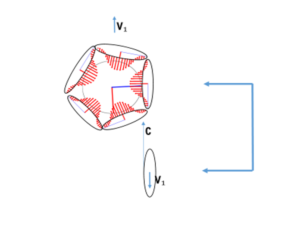Some behavioral characteristics of electrons arranged in a dodecahedron.
1.Build up of gravitational attraction through free magnetic energy.
An illustration by the forming of the dodecahedron was:

Before the encounter, all 12 electrons are propagating at relativistic speed. After the encounter and forming the arrangement of the dodecahedron, that speed became zero relative to the speed of light.
As a consequence, each electron in the dodecahedron loads itself in the direction of its propagation with kinetic energy at a level ½mV². V is the speed differential. The relativistic speed of a naked electron is its proper natural speed at which formation into the electron took place. This loading characteristic with kinetic energy is unknown in regular science. The load in kinetic energy is the equivalent of the transformation of free electric energy in free magnetic energy, by reduction of the frequency of the electron system. The addition to the magnetic manifestation of the electron is the ΔhF. That is counterintuitive because in regular science we apply the hidden assumption that the natural rest speed of an electron is unknown. Tests near 0 ⁰K show electrons still have speed.
This increase in the magnetic manifestation of each electron reflects in surface inflation for the electron and volume inflation for de dodecahedron.
Per illustration:
Electron inflation

Dodecahedron arrangement in a simplified animation:
Regular science identifies the additional free magnetic manifestation as mass manifestation.
2.Oscillation without spinor rotation
Another characteristic is that the electrons in the dodecahedron arrangement continue to oscillate and at the frequency of approx 10¹⁴ Hz.
In two animations:
The dodecahedron arrangement limits the electrons to make spinor rotations.
3. Electromagnetically neutral behavior
In the outside world, such a single dodecahedron exhibits no noticeable resultant electrical manifestation, nor a resulting ½ spin behavior. To sum it up, such a dodecahedron act as black matter, showing so-called mass related behavior like gravitational attraction and inertia only.
4. Natural rest speed zero, inertia capability
Another observation concerns the potential breach of the speed of light of the entities involved, include their electromagnetic manifestations as well. For illustration: on each face of the dodecahedron, there is a photon that orbits at the speed of light. That means that whenever a dodecahedron would accelerate in a certain direction, then the resultant speed of one or more of its photons could exceed the speed of light.
That is not possible, and therefore the speed of the dodecahedron relative to the speed of light is zero at the very moment this construct emerges. In other words, the natural speed of the dodecahedron versus the speed of light is zero.
However, we know that we can accelerate an object.
That triggers the question: what prevents any of such photons from exceeding the speed of light while being accelerated?
In illustration:

When a dodecahedron accelerates out of its natural rest speed, being zero relative to the speed of light, then within the construct, additional compensating circular vibrations are mandatory to avoid overspeeding. It is a rather complex set of vibrations that deforms the dodecahedron whenever and wherever necessary to avoid overspeeding of the manifestations. These vibrations are direction sensitive. These circular vibrations are direction sensitive and require the external input of energy. It is this required input of energy during acceleration that we experience as the inertial behavior of objects in daily life. Once accelerated, this system of vibrational compensation is energy stored as kinetic energy in the construct dodecahedron.
It is impressive, that this configuration of electrons in the spatial form of a dodecahedron has by itself the speed of light available as the reference to accommodate any acceleration along whatever Euclidean axes. Any acceleration against inertia, being the introduction of the compensating vibrations is stored within the construct dodecahedron as reversible kinetic energy and exactly along its axis of variation in speed. That is irrespective of any rotation of the dodecahedron in due time. This system is self-adjusting and therefore preserving the history of acceleration.
5. Interference capability with other dodecahedrons
While a single dodecahedron acts in effect as “black matter” and showing little or no interaction with the outside world, it is conceivably feasible that a dodecahedron may interact with yet another single dodecahedron.
